The iPad Air Review
by Anand Lal Shimpi on October 29, 2013 9:00 PM ESTiPhone to iPad: CPU Changes
Although the iPad Air uses the same A7 from the iPhone 5s (and M7 motion coprocessor), there are a few minor differences that do lead to better performance.
At a high level we’re still talking about two 64-bit Apple Cyclone cores with 128KB L1s (64KB I$ + 64KB D$) per core, a shared 1MB L2 cache and a 4MB L3 cache that services the entire SoC. Apple increased CPU frequency from 1.3GHz to 1.4GHz in the iPad Air, a mild increase but in line with what we’ve seen from previous iPad designs. That’s the first impact on performance - a 7.69% increase in CPU frequency.
The second impact on performance is something I only noticed while digging around under the hood of the A7. It seems like the implementation in the iPad Air can, for whatever reason, hold more instructions in flight (over 20% more) than the A7 in the iPhone 5s. It’s unclear to me whether the A7 in the iPad is configured any differently via firmware/microcode or if perhaps we’re looking at a slightly different revision of the core, but the delta was repeatable in my testing.
The third, and likely biggest change impacting the iPad Air’s implementation of the A7 is the additional thermal headroom afforded by the larger chassis. I’m not going to go into details on exactly what this next test does (unfortunately we’re going to occlude some of the low level work that we do in light of all of the benchmark cheating going on), but we’re looking at a curve of performance vs. time for a particularly power heavy mix of code. We’re running the same exact code on both the iPad Air and iPhone 5s here, the only real difference is the size of the chassis:
You can see the 5s throttles back its CPU frequency to about 1GHz after the 2 minute mark. The crazy thing is that until that point the 5s manages to run at full frequency without so much as a hiccup for two full minutes, running an incredibly power hungry task. Given that most iOS apps aren’t this power intensive for such a sustained period of time, iPhone 5s users should almost always see the A7 running at a full 1.3GHz. Pretty crazy.
The iPad Air by comparison shows much more controlled behavior. Early on in the test we see a 7.7% performance advantage, which lines up perfectly with the iPad Air’s 7.7% CPU frequency advantage. By the end of the test the iPhone 5s has throttled to 900MHz, while the iPad Air drops to around 1.2GHz. At this point the iPad Air’s performance advantage grows to almost 40%.
CPU Performance
I've gone through our standard set of cross-platform browser based benchmarks to place the iPad Air's performance in perspective. As I mentioned in our 5s review, I don't know that there are many (any?) applications on iOS 7 that can really take advantage of all the A7 has to offer. There's definitely a ton of headroom left in the design. What's particularly exciting is when the A7 ends up in n-1 or n-2 iOS devices and it becomes the minimum developer target going forward.
I won't go through all of the results here again, but it's safe to say that the iPad Air is the fastest ARM based tablet on the planet at this point.
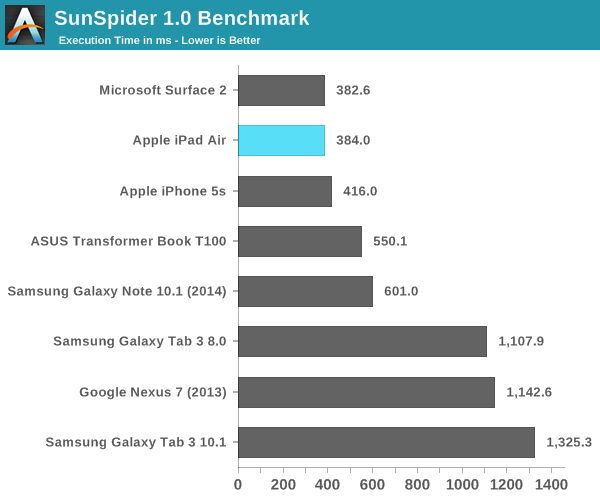
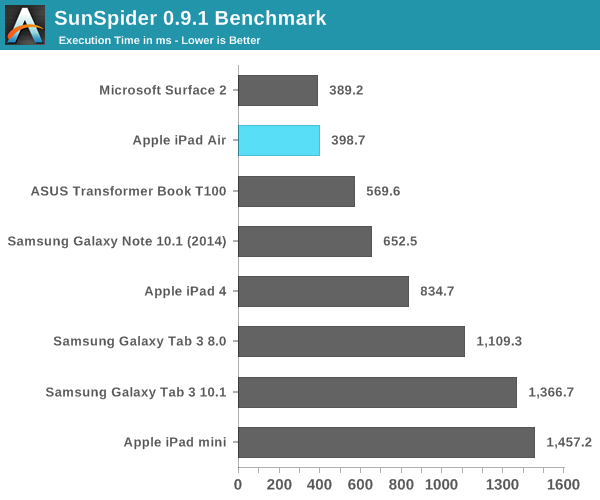
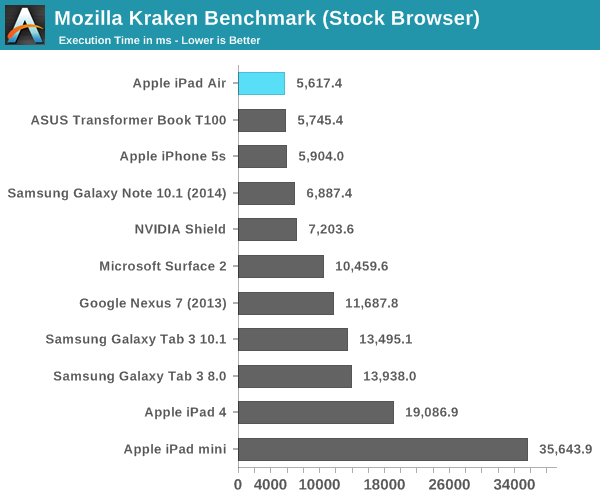
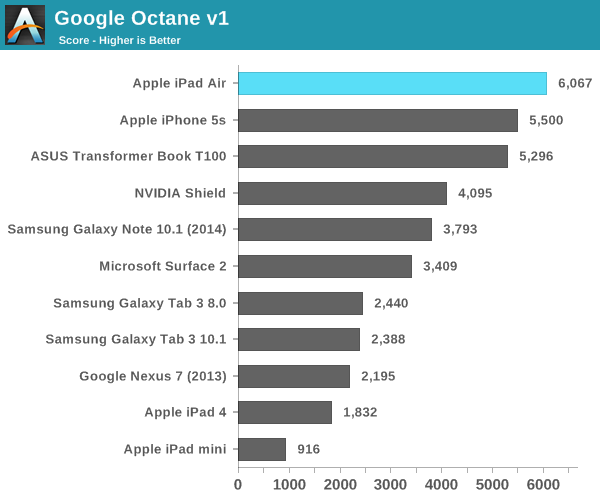
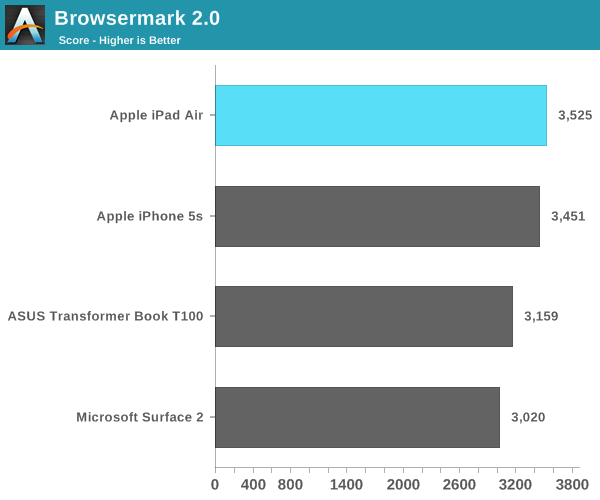

A7 Power Consumption
I’ll get to battery life in a bit, but I’ve been curious about the dynamic range of power consumption offered by Apple’s new A7 SoC. On the one hand we’re dealing with a lower power process (28nm vs. 32nm), but on the other hand Apple’s Cyclone cores can clearly draw more power given how beefy the architecture is this round. Apple frowns upon review sample dissection so I had to turn to a less scientific method of external platform level power measurement. The fidelity of the numbers here aren’t all that great but it’s better than nothing.
For the first test I measured platform power consumption during a Kraken run:
I purposely started measuring before the benchmark so I could get an idea of idle power consumption. The iPad Air consumes roughly 72% of the idle power as the iPad 4, both running at the same brightness. Here we’re not just seeing the A7’s advantages but also things like lower display power.
Focusing on the load portion of the measurement we see that both the new iPad and old iPad consume the same total power in this test. I suspect the A7 is drawing more power than the A6X, but it’s masked by a lower power display. Given how much faster the iPad Air is, Apple’s latest tablet features far lower overall task energy than the outgoing iPad 4. This is probably both the best case scenario for the iPad Air and the most likely case as well.
For kicks I wanted to see just how much power I could get the iPad Air to draw. Here I’m looking at platform power during our mini-power-virus test from above:
How’s that for dynamic range? Almost 12W running all out, but around half that in what we’d normally consider to be a stressful CPU test. I couldn’t get any actual applications/games on the iPad Air to behave like this so the results above are purely academic (for now). A quick run through GFXBench 2.7’s T-Rex HD test confirms that even pushing the GPU won’t hit these numbers. The max I saw running T-Rex offscreen was ~6W, and turning to an actual game (Infinity Blade 3) the iPad Air pulls less than 5W.


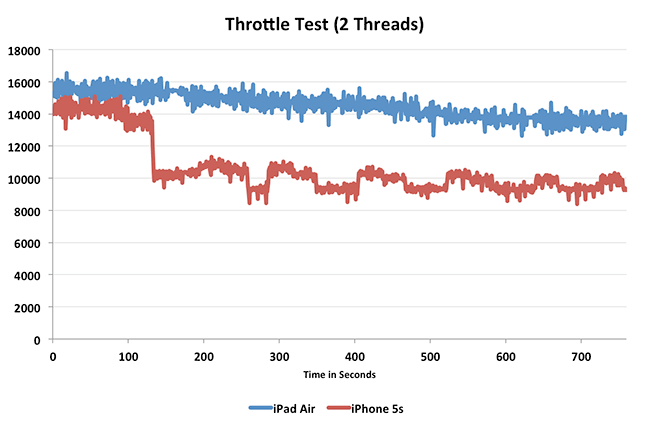
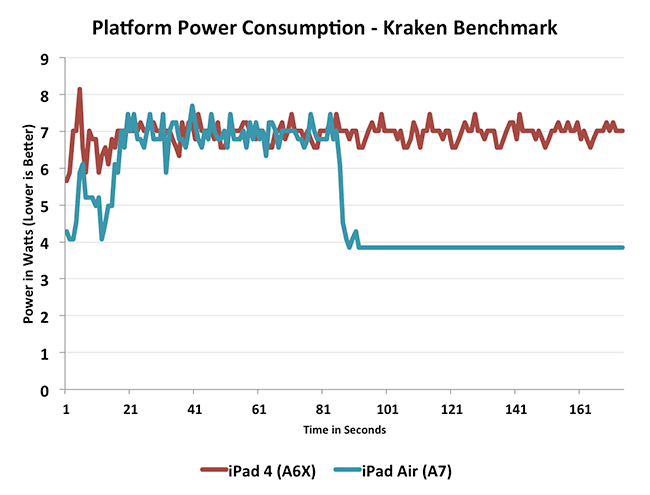
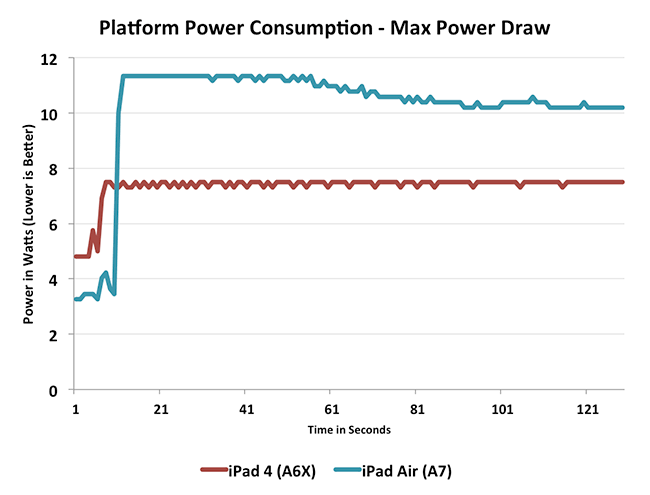








444 Comments
View All Comments
Kvaern - Wednesday, October 30, 2013 - link
You bought a first generation tech device and if you expected that to bring solid performance to the table for 5-8 years then I'm afraid it's your expectations that are the issue at hand, not the device.aliasfox - Wednesday, October 30, 2013 - link
Well, I knew I should've waited for the iPad 2, but I was taking a long trip in the fall of 2010 and it was by far the best option for internet connectivity at the time.As for 5-8 years... well, it's more that I expect $700 to last me longer. All of my other 3-4 yr old devices may be beat up, slow, and not great, but unlike the iPad 1 (on iOS5), they are still reasonably usable.
zogus - Wednesday, October 30, 2013 - link
As an owner of iPad 1 who've found the lack of iOS 6 update frustrating, I understand your sentiment completely, and I'm kind of on the fence myself regarding the new iPads.There is one major difference between the iPad 1 situation and iPad Air, however: iPad 1 was followed less than three months later by iPhone 4, which had twice as much RAM, at which point anyone remotely tech-y could see the writing on the wall. iPad Air is not likely to have that kind of upstaging for a couple of years since iPhone 5S is still brand new, and the large number of 512MB units (iPhone 4/4S, iPad 2, iPad mini) need to be taken off the market first. Apple cannot afford to bloat iOS to the point where 1GB is insufficient for a some years to come.
aliasfox - Wednesday, October 30, 2013 - link
At the time the iPad 1 came out, it had equivalent RAM to the (then top of the line) 3GS, and twice as much as the first two iPhones and first few generations if iPod Touches. Granted, between the iPad 2/3, iPhone 4/4s, and iPad mini they've sold a boatload more 512MB devices, but the difference is a matter of scale.akdj - Wednesday, October 30, 2013 - link
Yet with an A7 device (iPhone 5s/iPad Air/iPad mini w/retina) one can now run 32 tracks in Garage Band vs. 16 on the same memory 'starved' iPad 4? More memory will come...it's a non-isssue. The iPad 2 is now in the hands of 10s of thousands of pilots on commercial airlines. Their Jep Charts and approach plates...user manuals and updates to said charts and plates work just fine.Guys/Gals....this isn't Windows. This isn't Android. Apple's conservative RAM approach significantly improves battery life...and doesn't at all seem to affect actually running currently available apps that haven't been built with iOS7 in mind, much less 64bit programming! The vast majority of apps currently available are optimized to the A5 processor with 512mb of RAM. You'll be fine...I know I sure am on both my iPad 4 and iPhone 5s. If you need 10 tabs open on Safari while manipulating photos and listening to music, buy a laptop!
stacey94 - Wednesday, October 30, 2013 - link
Isn't RAM fairly cheap anyway? It's not consuming that much power either. I don't understand the logic behind skimping on it.Spunjji - Tuesday, November 5, 2013 - link
Planned obsolescence. Simple as that.nedjinski - Tuesday, October 29, 2013 - link
Kindle Fire HDX 8.9 still beats it - sorry.Fly Molo - Tuesday, October 29, 2013 - link
...That just happened.dragonsqrrl - Wednesday, October 30, 2013 - link
...yep, unfortunately